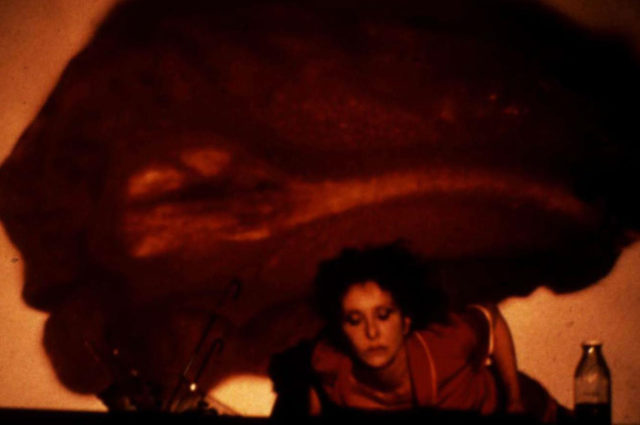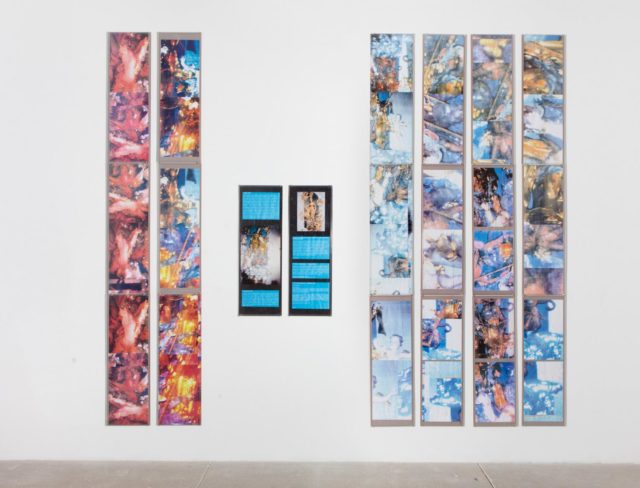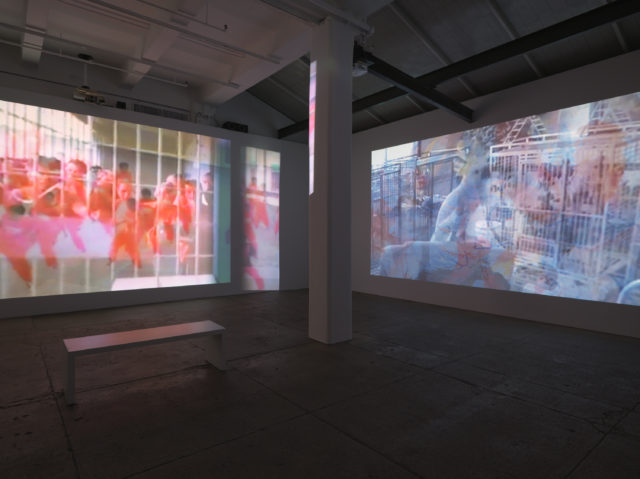
Carolee Schneemann, Fresh Blood, 1983/2004, c-print (© Carolee Schneemann; Courtesy PPOW Gallery; Photo: James Brown)
Carolee Schneemann: Further Evidence–Exhibit A
PPOW Gallery
535 West 22nd Street, 3rd Floor
New York, NY
Carolee Schneemann: Further Evidence–Exhibit B
Galerie Lelong
528 West 26th Street
New York, NY
Both shows on view until December 3, 2016
A week after the election, women’s bodies are a battleground yet again. Donald Trump hinted at overturning Roe v. Wade on 60 Minutes and Paul Ryan thought birth control was a “nitty-gritty detail” of the dismantlement of the Affordable Care Act. This isn’t even taking into consideration the pussy-grabbing rhetoric of the campaign. With President-elect Trump and a Republican majority in Congress, women–like many diverse populations–feel newly under siege.
This danger to women’s health and civil liberties inadvertently breathes new life into art that engages with the female body and its subjugation. While using the body, in the recent past, may have felt like Feminism 101, art now needs to reflect and reject this patriarchal threat. Feminist art stalwart Carolee Schneemann achieves just that in her dual exhibitions Further Evidence–Exhibit A at PPOW Gallery and Further Evidence–Exhibit B at Galerie Lelong. In these dual shows, Schneemann depicts the female body as contested, controlled and imprisoned. And it couldn’t feel more timely.
Both exhibitions display lesser known installations, videos and collages made in the decades after her more iconic and art historically friendly performances from the 1960s and 1970s. It’s not hard to see why these works never gained the same popularity or notoriety. The art in the two shows is deeply disturbing. Sure, Meat Joy is bloody, but it’s not bleak. This might have been a problem in cheerier political times, but in the context of our national waking nightmare, Schneemann’s violent imagery resonated.
PPOW’s Further Evidence–Exhibit A provides the most palatable way to ease into Schneemann’s feminist dystopia. The gallery opens with a series of archival spiraled maquettes made for her larger installation Venus Vectors. With scribbled marker on glass, these star-shaped works portray lists of V shapes, reflecting Schneemann’s understanding of the V as representative of a woman’s body (i.e. vulva, vagina, etc.). Nearby, her video Fresh Blood–A Dream Morphology features the artist dressed in a menstrual blood red outfit, posing and dancing with an umbrella. It looks like a fever dream, but it still maintains a recognizable physical celebration of womanhood that appears in her earlier work.

Carolee Schneemann, Plague Column: Known Unknown, 1995, Mixed media installation (© Carolee Schneemann; Courtesy PPOW)
These more classic Schneemann pieces are overpowered by her turn toward analyzing the various ways women’s bodies suffer. Take, for example, her 1995 installation Plague Column: Known/Unknown. The concept derives from a 17th century Viennese sculpture known as a plague column. As seen in numerous reproductions scattered around the back gallery, the sculpture depicts the Virgin Mary as a warrior figure impaling a hideous witch. Here, the witch symbolizes the bubonic plague. With a woman’s unattractive and attacked body as the personification of a fatal illness, Schneemann launches into a critique of medicine’s militarized conception of “battling” cancer and how this translates to women’s bodies.
Taken as a whole, the installation is a lot to take in. Wall panels surround the perimeter of the room, covered in images of the plague column, enlarged cancer cells and moving testimony from people with cancer. A circle of television monitors on the floor play a seizure-inducing range of spliced together clips ranging from a close-up of penetration to the clanging dint of falling test tubes and other medical equipment. Inside the ring of televisions lie glowing disembodied breasts in a tangle of medical equipment. The breasts recall the physical horror of mastectomy–a casualty in the military conception of cancer treatment.

Carolee Schneemann, Further Evidence: – Exhibit A, installation view, PPOW, (© Carolee Schneemann; Courtesy PPOW)
The most conceptually interesting part of Plague Column is a group of oranges impaled–or penetrated–with hypodermic needles suspended in the corner of the room. These oranges are rotting–withered and covered with sickly white and green mold. They also give off a cloying and nauseatingly sweet smell. In the context of the installation as a whole, the oranges project numerous bodily connotations whether tumors, cancer cells or breasts. With the abundant piercing needles, the piece recalls another long-suffering icon–Saint Sebastian, recalling a powerless martyrdom. It reflects the lack of agency of the women’s body’s subjection to deteriorating disease and its treatment.
These painful themes are further articulated at Galerie Lelong’s Further Evidence–Exhibit B. The first thing I saw stepping into the video room to the right of the gallery’s entrance was a flash of smashed skull with scattered brains and blood on a pavement. This was just one of the troubling visions in Schneemann’s multi-channel video installation Devour. With four televisions and one two-channel video screen, the installation is a barrage of visual information ranging from the upsetting to the tenderly wacky like Schneemann kissing her cat. This nausea was only strengthened by her Caged Cats collages, which employ photographs of cats waiting to be killed for food in China.

Carolee Schneemann, Precarious, 2009, Multichannel video installation, motorized mirror system, Installation view: Galerie Lelong, New York, 2016 (© Carolee Schneemann; Courtesy Galerie Lelong, New York)
While Caged Cats is hard to take both morally and artistically, the caged theme worked to create her most engaging installation in this exhibition–and perhaps of the two shows overall. Precarious offers the most blatant and incisive critique of the perilous place of a woman’s body in society. Shown in Lelong’s larger room, the work fully envelops viewers with its found imagery using a mirrored technique that sends the images spinning around the room. Viewers might recognize some of the clips from viral videos such as a boogieing cockatiel and inmates in the Philippines dancing to Michael Jackson. In addition, she also includes a dancing bear in Russia and most notably, her own performances.
By placing her own body into the same reel, she conflates her own movements, as well as her body as a whole, with being imprisoned and forced to perform. Admittedly, it is pretty self-indulgent coming from a successful white woman artist. And yet, she makes a worthwhile critique. On a certain level, women are required to perform in our society. Just think of the typical catcall, “Smile.” While it’s not as restrictive as being in prison, of course, a woman’s body is heavily policed within a set of social norms. With her title, Schneemann asserts that women inhabit a precarious place in society if they don’t perform correctly or refuse the performance all together.
Schneemann, though, offers a glimmer of hope in the installation. By sending the imagery throughout the spacious gallery, she essentially “escapes” the prison of the rectangular video screen. Granted, this is a minor and technically wonky moment of transcendence within two incredibly bleak exhibitions. But Precarious’ projected freedom offers, at least, a bit of promise and a reminder of agency within repressive societies. Is it enough to quell the anxiety about the unending parade of frightening political news for women this week? No, but right now, I’ll take any hope I can get, no matter how short-lived.


Comments on this entry are closed.